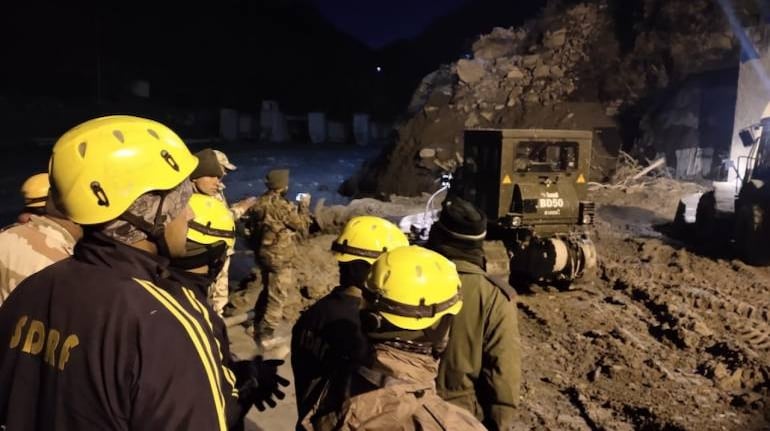International geologists and glaciologists studying satellite imagery say the cause of the flooding disaster to be a landslide and not a glacial outburst
February 09, 2021 / 08:22 AM IST

Multiple agencies are working at rescuing over 30 workers feared trapped inside a big tunnel at Tapovan. (Image: PIB in Uttarakhand)
Climate Change? Glacier lake outburst flood? Natural disaster? Manmade calamity? Deforestation? Dams? Roads? Greed? Gods?
The jury is out on what caused the latest Himalayan disaster, when a part of Nandadevi glacier broke off in the Uttarakhand's Chamoli district on February 7 morning, causing massive floods in the Dhauliganga and Rishiganga rivers.
At the time of writing, at least 19 people have been killed, and 150 are missing. The floods also caused major damage to the National Thermal Power Corporation's (NTPC) recently commissioned Tapovan Vishnugad 520 MW hydro-electric project and the under-construction 13.2 MW Rishiganga mini-hydel project, as well as to several homes, roads and at least half a dozen bridges. Most of the missing persons were workers deployed at NTPC's hydropower site.
While media and commentators were quick to attribute the disaster to Climate Change and melting glaciers, specifically GLOFs (glacial lake outburst floods), activists and experts in the Himalayan region have blamed the ecological destruction caused by the unholy rush to build ill-advised dams and roads in this fragile region for the loss of life and property.
Meanwhile, international geologists and glaciologists studying satellite imagery say the cause of the flooding disaster to be a landslide and not a glacial outburst. Dan Shugar of the University of Calgary, who specialises in high altitude glacial and geologic environments, used satellite images from Planet Labs, captured before and after the disaster, and identified a steeply hanging bit of a glacier which likely developed a crack and caused a landslide, triggering an avalanche and the subsequent flooding. Images from the Copernicus Sentinel 2 satellite also showed the formation or opening of a crack in the Nanda Devi glacier that is believed to have triggered the landslide.
The truth is that Uttarakhand's upper reaches, source of several small rivers that feed the Ganga, already has 16 dams, and another 13 are under construction. The Uttarakhand government has proposed another 54 dams on these rivers. On the Dhauliganga River, eight back-to-back new hydel projects are proposed in addition to NTPC's Tapovan project. Blasting of mountains, stone quarrying and digging of tunnels in the fragile mountain system base for the two back-to-back under-construction dams on Rishiganga and Dhauliganga rivers has played havoc with the local ecology.
Incidentally, the Tapovan project started in 2006 and was scheduled to be commissioned in 2013, but the devastating flood in 2013 affected the construction process. Earlier, the project's cost was estimated to be Rs 2,978.5 crore, which was later revised to Rs 5,867.4 crore due to time and cost overruns. The NTPC has already spent more than Rs 4,467 crore on the site.
Although further investigations are required, the fingerprint of Climate Change cannot be ruled out; after all, the India Meteorological Department has recorded January 2021 to be the warmest January in Uttarakhand in six decades.
According to the UN intergovernmental panel on climate change (IPCC), in many high mountain areas, glacier retreat and permafrost thaw are projected to further decrease the stability of slopes, and the number and area of glacier lakes will continue to increase. Floods due to glacier lake outburst or rain-on-snow, landslides and snow avalanches, are projected to occur also in new locations or different seasons.
The Indian Space Research Organisation's resource centre on Himalayan glaciers reveals that glacier melting in the Central Himalayan catchment area, where Chamoli is located, has increased in the first 20 years of this century.
According to the Hindu Kush Himalayan Monitoring and Assessment Programme (HIMAP), co-ordinated by the International Centre for Integrated Mountain Development (ICIMOD), glacier retreat (and some advance) in the face of Climate Change will make the fragile mountains more prone to natural disasters such as landslides, and will make the impact of other natural disasters, such as earthquakes, far greater.
Variations in rainfall will continue to rise, setting in place the possibility of catastrophic flooding. At the same time, springs have been reducing their flows in the hills, which may increase, leading to drought among communities that already have higher-than-national-average rates of poverty.
Ironically, lest we forget, Chamoli, home to Badrinath, Hemkund Sahib, Nandadevi Biosphere reserve and Valley of Flowers, is also the birthplace of the ‘Chipko movement’, and the famous slogan of Sunderalal Bahuguna, “Ecology is the permanent economy.”
We were warned.
Shailendra Yashwant is senior advisor, Climate Action Network South Asia (CANSA). Twitter: @shaibaba. Views are personal.
First published in Moneycontrol Opinion
No comments:
Post a Comment